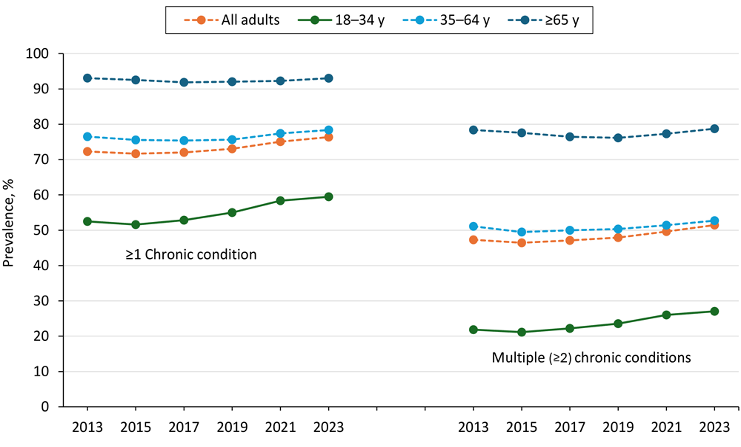A Generation Growing Up Sick
In the last ten years, rates of obesity, depression, high blood pressure, and other chronic conditions have increased among young adults.

Read Time: 2 minutes
Published:
Young adulthood in America is starting to look a lot less healthy. New national data show that chronic illnesses—once expected to appear in middle or old age—are now appearing in people as young as their 20s and 30s. In just the last ten years, rates of obesity, depression, high blood pressure, and other chronic conditions have increased among young adults. Developing chronic conditions so early in life can set the stage for decades of poor health and a higher risk of premature death.
According to a new CDC study led by Kathleen Watson, chronic illness is not a distant concern but a defining reality for many in young adulthood, with consequences that can reverberate for a lifetime. Using a decade of data from the Behavioral Risk Factor Surveillance System (a national survey of more than 2.6 million U.S. adults), they found that nearly 60% of adults aged 18 to 34 reported at least one chronic condition.
Even more alarming, over a quarter (more than 19 million young adults) were living with two or more. For many, it’s a combination of asthma, diabetes, migraines, arthritis, or autoimmune disorders, conditions that complicate daily routines and limit opportunities in work, school, and relationships.

One of the clearest indicators of this trend is the sharp rise in depression and obesity. Among young adults, obesity rates jumped from 22% to 27% between 2013 and 2023, while depression soared from 16% to 25%.
Hypertension, diabetes, and asthma are also on the rise. These conditions often occur together, creating more serious health risks over time. This clustering, or ‘multimorbidity,’ raises the risk of long-term disability and serious health conditions. It can make daily life unpredictable, sap energy, compound stress, and disrupt stability in early adulthood.
Prevention requires tackling upstream drivers of chronic disease by expanding access to affordable, healthy food, investing in preventive mental health care, and creating safer, more walkable neighborhoods.
With bold investments in prevention, we can shift the trajectory so that chronic illness is not the defining story of current and future generations.



